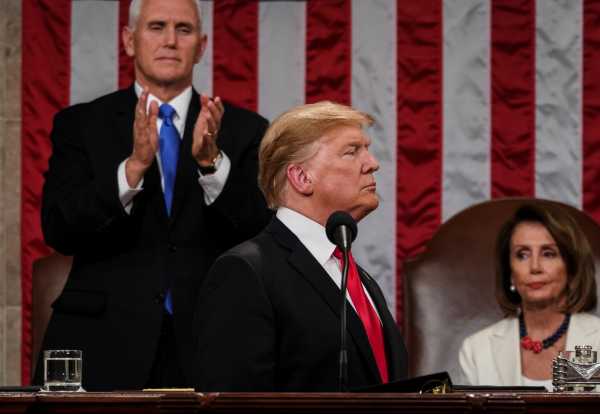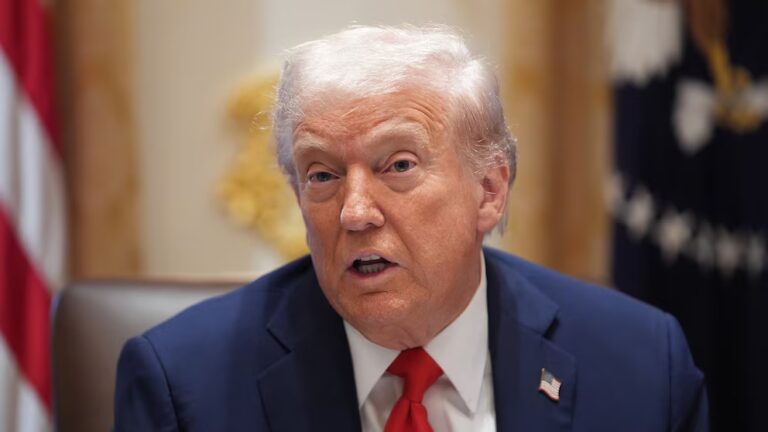
President Donald Trump’s administration unveiled its third budget proposal Monday, cementing a vision for the United States that bolsters funding for defense and border walls, while severely cutting social programs for the nation’s poorest.
The $4.7 trillion budget proposal, which encompasses everything from funding for food aid, education, and health care to national defense, seeks to slash $845 billion from Medicare — a program Trump notably promised to leave untouched — $241 billion from Medicaid through major structural reforms, as well as a 9 percent cut across non-defense programs, all while increasing the defense budget to $750 billion, 5 percent more than the 2019 budget.
Additionally, Trump’s administration has asked Congress for $8.6 billion for the president’s border wall, a project the president declared a national emergency over earlier this year amid the nation’s longest government shutdown in history.
The proposal also predicts significant economic growth over the next decade — at about 3 percent annually — with the expectation that the government will continue to enact tax cuts and a deregulatory agenda. The projections are far rosier than what outside forecasters expect.
Trump’s proposal comes during a tense time in congressional budget negotiations. As Dylan Scott has explained for Vox, in the coming weeks lawmakers will have to reach a new deal over budget caps to prevent automatic spending cuts, because of a sequestration policy Barack Obama negotiated with Republicans in 2011. The federal debt ceiling — a legal cap to how much money the government can borrow — was technically breached on March 1, but the Treasury Department has been able to implement extraordinary measures to buy Congress more time.
With a Democrat-controlled House, and a number of Republican senators facing difficult reelection bids next year, the White House’s budget proposal will likely have a short lifespan in Congress.
But ahead of a 2020 election cycle, as Democratic presidential candidates continue to unveil proposals to increase taxes on the wealthy to boost the nation’s social safety net, it’s clear Trump is offering the opposite vision.
Trump’s budget wants to cut the social safety net and build a wall
Trump’s budget proposal has a clear trade-off: The White House wants to gut the nation’s social safety net to give more funding to nation’s defense programs and allow for tax cuts primarily benefiting corporations and America’s wealthiest.
The White House is proposing cutting programs like Medicare and Social Security — that Trump campaigned on protecting — and increasing defense and border security spending.
If Trump’s budget were to be enacted, some of the biggest policy changes would include:
- $1.5 trillion in cuts to Medicaid over 10 years, implementing work requirements as well as eliminating the Medicaid expansion under the Affordable Care Act. The budget instead adds $1.2 trillion for a “Market Based Health Care Grant” — block grant to states, instead of paying by need. It’s not clear whether that would be part of Medicaid.
- An $845 billion cut to Medicare over 10 years, about a 10 percent cut, to be achieved through targeting wasteful spending and provider payments and lowering prescription drug costs.
- $25 billion in cuts to Social Security over 10 years, including cuts to disability insurance.
- A $220 billion cut to Supplemental Nutrition Assistance Program (SNAP), commonly referred to as food stamps, over 10 years, including mandatory work requirements. The program currently serves around 45 million people.
- A $21 billion cut to Temporary Assistance for Needy Families, an already severely underfunded cash-assistance program for the nation’s poorest.
- $207 billion in cuts to the student loan program, eliminating the Public Service Loan Forgiveness program and cutting subsidized student loans.
- Increases defense spending by $34 billion next year, to a $750 billion budget baseline. That makes up a 5 percent boost to defense and military spending. To keep the defense budget within current caps, the White House uses a gimmick, putting $164 billion of this budget increase in an uncapped overseas contingency (OCO) fund.
- $8.6 billion in funding for the southern border wall, separated between increased funding for the Department of Homeland Security and funding for military construction.
- Overall, there is a 9 percent cut to non-defense programs, which would hit Section 8 housing vouchers, public housing programs, Head Start, the Women, Infants, and Children (WIC) nutrition program, and Low Income Home Energy Assistance Program, among others.
The Trump administration is proud of the proposed cuts.
“This budget will have more reductions in spending than any president in history has ever proposed,” a senior administration official told reporters Monday, expressing concern about the national debt. The deficit has swelled under Republican leadership in large part because of the tax cuts enacted last year. Trump’s administration, however, has balked at the notion that the decrease in revenue from cutting corporate taxes is the root cause of the growing debt.
“It’s not that Americans are taxed too little, it’s that Washington spends too much,” Russ Vought, the Office of Management and Budget’s deputy director, penned in a Fox News op-ed Monday.
The Trump administration is predicting the economy will continue growing really fast
A core part of Trump’s budget is the assumption that the economy will continue to grow — and rapidly.
While the Congressional Budget Office predicts growth will sit between 1.6 and 1.8 percent over the next decade, and the Federal Reserve settled around 2 percent annual growth, the Trump administration says growth will surpass 3 percent this year, then level out at around 2.8 percent by 2029.
This administration has always put forward rosy economic projections that have defied economic consensus.
The White House will point out that the economy has exceeded outside forecasts so far. In 2017, the White House budget projected 2.3 percent growth, and it actually reached 2.5 percent in the fourth quarter compared to the previous year.
Last year, the Trump administration expected the economy to grow 3.1 percent, which, as Vox’s Dylan Matthews wrote last year, far outpaced predictions from private sector forecasters. They estimated growth closer to 2.15 percent, and the Congressional Budget Office projected growth at 1.4 to 1.9 percent.
Between government-issued numbers and Wall Street forecasters, the economy grew between 2.9 and 3.1 percent in 2018, essentially line with the Trump administration’s projections.
That said, revenue has drastically dropped. In 2018, the federal government’s revenue was only up 0.4 percent — one of the lowest growth rates in half a century. According to the Committee for a Responsible Federal Budget, a bipartisan group that advocates for fiscal responsibility, the slow revenue rate was in large part due to the tax bill. Taking inflation into account, federal revenues were actually down between 4 to 9 percent this year because of the tax cuts.
Is any of this Trump budget going to actually happen?
Trump’s budgets haven’t come close to being enacted by Congress in the past two years.
Top-ranking Democrats in charge of the budgeting process have already panned the request. The House Budget Committee chair, Rep. John Yarmuth (D-KY), called the proposal “irresponsible” and a “cynical vision for our country.” And Rep. Nita Lowey (D-NY), who leads the House’s powerful Appropriations Committee, strongly implied the proposal would be ignored altogether.
“President Trump has somehow managed to produce a budget request even more untethered from reality than his past two,” Lowey said in a statement. “With such misguided priorities, the Trump budget has no chance of garnering the necessary bipartisan support to become law. I am committed to working with my colleagues, both Democrats and Republicans, to write appropriations bills that responsibly fund the government.”
Those seeking the 2020 Democratic presidential nomination have also criticized the proposal.
“The Trump budget is breathtaking in its degree of cruelty and filled with broken promises,” Sen. Bernie Sanders (I-VT) said.
“This would hurt our seniors and is yet another piece of evidence for why we need a new president,” Sen. Kamala Harris (D-CA) said.
Congress has to negotiate a budget caps deal in the coming weeks to avoid across the board cuts to both defense and non-defense programs — something both Republicans and Democrats want to avoid. Trump’s proposal establishes a very conservative starting position.
The past year has shown Trump is willing to play hardball on government spending. The president partially shut down the federal government for more than a month at the start of 2019 over less than $2 billion in border security funding.
Then again, going into a presidential election cycle fighting for serious cuts to Medicare and Social Security — both programs Trump promised to never touch — among other programs, would be a bold and risky political position.
Sourse: vox.com






